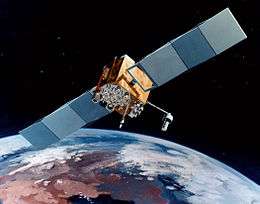USA-242
 Artist's impression of a GPS IIF satellite | |
| Mission type | Navigation |
|---|---|
| Operator | US Air Force |
| COSPAR ID | 2013-023A |
| SATCAT № | 39166 |
| Mission duration | 12 years (planned) |
| Spacecraft properties | |
| Spacecraft | GPS SVN-66 (IIF-4) |
| Spacecraft type | GPS Block IIF |
| Manufacturer | Boeing |
| Launch mass | 1,630 kilograms (3,590 lb)[1] |
| Start of mission | |
| Launch date | 15 May 2013, 21:38 UTC |
| Rocket | Atlas V 401, AV-039 |
| Launch site | Cape Canaveral SLC-41 |
| Contractor | ULA |
| Orbital parameters | |
| Reference system | Geocentric |
| Regime |
Medium Earth (Semi-synchronous) |
| Perigee | 20,459 kilometers (12,713 mi)[2] |
| Apogee | 20,459 kilometers (12,713 mi)[2] |
| Inclination | 55 degrees[2] |
| Period | 12 hours |
| Epoch | Target |
USA-242, also known as GPS IIF-4, GPS IIF SV-5 and Vega,[3] is an American navigation satellite which was launched on 15 May 2013 and became operational on 21 June 2013.[4] The fourth Block IIF GPS satellite, it forms part of the Global Positioning System.
USA-242 is a 1,630-kilogram (3,590 lb) spacecraft, built by Boeing with a design life of 15 years.[1] It operates from a semi-synchronous medium Earth orbit, at an altitude of 20,459 kilometers (12,713 mi) an inclination of 55 degrees,[2] in slot 5 of plane C of the GPS constellation.[5] The new satellite was originally intended to replace the seventeen-year-old USA-117 satellite,[6] but currently both USA-117 (SVN-33) and USA-242 (SVN-66) are in active use.[7] USA-242 broadcasts its navigation signals using the PRN-27 signal modulation.
United Launch Alliance conducted the launch of GPS IIF-4, using an Atlas V 401 carrier rocket. Launch took place from Space Launch Complex 41 at the Cape Canaveral Air Force Station, with liftoff occurring at 21:38 UTC on 15 May 2013, the beginning of an 18-minute launch window. The launch marked the first time since 1985 that a GPS satellite had launched on an Atlas rocket, or indeed any rocket other than a Delta.[6]
References
- 1 2 Krebs, Gunter. "GPS-2F (Navstar-2F)". Gunter's Space Page. Retrieved 15 May 2013.
- 1 2 3 4 "GPS IIF-4 Atlas V Mission Overview" (PDF). United Launch Alliance. Retrieved 15 May 2013.
- ↑ McDowell, Jonathan. "Issue 679 (draft)". Jonathan's Space Report. Retrieved 16 May 2013.
- ↑ "NANU 2013035". United States Coast Guard. Retrieved 25 June 2013.
- ↑ Ray, Justin. "Mission Status Center". Spaceflight Now. Retrieved 15 May 2013.
- 1 2 Graham, William (15 May 2013). "ULA Atlas V successfully [sic] deploys new GPS satellite". NASASpaceflight.com. Retrieved 16 May 2013.
- ↑ "GPS Constellation Status". United States Coast Guard. Retrieved 25 June 2013.